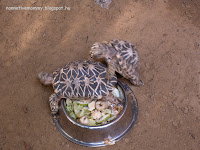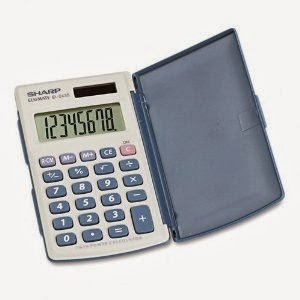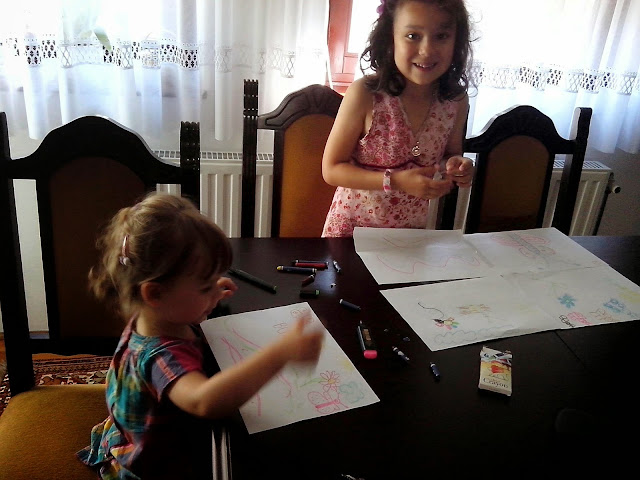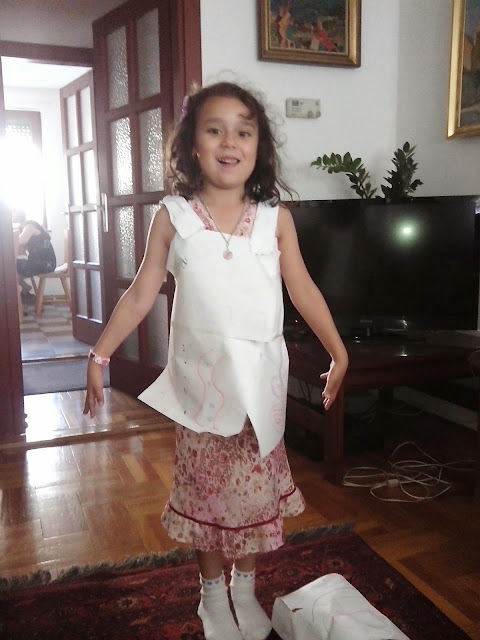August has arrived so we have taken part in another few days at our Helen Doron Language School. Here is the summary of our 3 sessions:
Day1: Fruits
I was really happy as this is one of E.'s favourite topics. Her eyes sparkled when she saw a picture of an apple and a straberry in the teacher's hand. She looked at me and glowed with delight. I felt she knew the whole session will be about fruits. So I wasn't surprised at all when in the middle of the lesson she was brave enough to say apple, pear and nana (for banana). She says strawberry in Hungarian (she always chooses the easier word of the two languages - very smart). The activities we had:
- matching half fruit
- matching fruit with their shapes
- sticking fruit on a big tree
- taking plastic fruits out of a pelican's beak then put them back
- turning flashcards facing down
- fruit song ( I like bananas...)
And of course the usual revisions, like the Uppety song or the Waving song.
 |
| E. is waving to Rosie, the doll (on the 3rd day) |
The teacher in me would have included the colours a little bit.
I was taken aback when the picture of an avocado came up. Well, we live in a different eating culture here in Hungary.
However, the main point is E. enjoyed herself a lot. I haven't seen her this active yet. And the number of mums and kids was better than at the beginning of July (6 mums with 6 kids - too many).
Day2: Animals
E. wasn't in a good mood today. We had a rough night and she was clinging to me all day. It was the same at the lesson. She was much less active, which was a pitty. As I could see the other kids were a little bit less patient than they usually are. But again E. said quite a few animal names and the sounds they make, too. (hippo, doggy, miaow, hee-haw)
We also listened to some real animal sounds and had to find the picture of the animal we could hear. It was also good fun, though there was some technical glitch, which also happened when we were listening to the animal sound song.
Another great activity was a bowl of water with plastic animals in it. I was scared to see the bowl full of water but nobody got wet, luckily, and the kids took great pleasure in splashing a bit in water. (Not to mention how refreshing it was in this heat). It is also a nice activity from sensory point of view. One of the reasons why I like the Helen Doron Early English is the wonderful combination of several kind of development involved at the lessons.
We also revised a little bit of the fruits (matching Velcro-ed fruit with their shape and matching one type of fruit with two of its kind with a marker on a white board - E. was interested in the latter as we started to do a little bit of drawing together).
 |
| Fruit activity - sorry, taken with a mobile |
After that the kids chose a toy animal from a big bag (E. said: 'choseone' as if it were one word) they had to lift it up and put it down, then turn it round while we were listening to the Uppety song.
All in all, it was a good day with plenty of varied activities, nice hand puppets, real-life animal sounds, some sensory game and great deal of moving around. I just wish E.'d had a better mood.
We finished on time and we could get home to our weekly Mums' English Club.
Day 3: Actions
This day was all about moving around. It was lovely, though towards the end the kids got a little carried away. But let's start with the beginning.
The group shrank a little, there were only 4 mums with their kids. We were banging drums, the door, the chair (E. sometimes hit her head a bit) with the drumsticks.
 |
| E. is picking drumsticks for banging |
The children were swinging in a blanket one by one, walking around slowly and quickly, turning around, clapping hands, touching face, stacking building blocks, pouring water, and most important of all, blowingbubbles among others. What else would a little explorer wish to do? All the activities were engaging and great fun for the kids. This time I managed to take some nicer photos. Have a look. The pics speak for themselves.
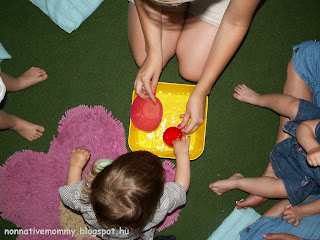 |
| Pouring water from a cup to a bowl |
 |
| "Stacking, stacking, stacking it up" |
 |
| I'll try it |
Every time I am amazed how brave E. is to say English words, more and more every day. She likes taking part in these sessions. She said purple, bubble, water, more, try it and shouted in the middle of the lesson: ORANGE ORANGE ORANGE. This must be the sign of her being entertained and feeling relaxed :) Well, I've already reached my main aim, then.













